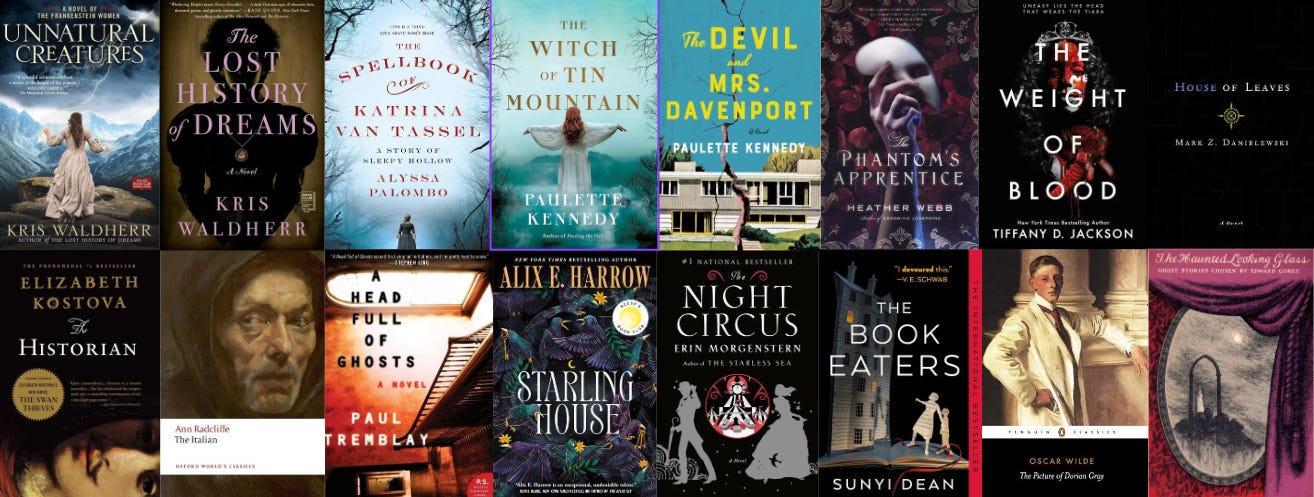Gothic novels have always fascinated me with their eerie, atmospheric settings, complex characters, and the ever-present sense of something dark lurking beneath the surface. When I wrote In the Garden of Monsters, I thought a lot about the great gothic novels I’ve always loved. My latest book is my take on that tradition—set in the surreal landscape of a monstrous garden in postwar Italy, but filled with all the hallmarks that fans of Gothic fiction will recognize and (hopefully) love.
At the heart of gothic fiction lies its setting, which often feels like a character in its own right. In my novel, In the Garden of Monsters, the Sacro Bosco—a Renaissance garden filled with strange statues of mythological creatures—serves as more than just a backdrop. Like the estate in The Haunting of Hill House by Shirley Jackson or the eerie mansion in Rebecca, the Sacro Bosco is both a place of beauty and danger, where history and myth collide. Its winding, overgrown paths and looming statues create a constant feeling of unease, as though the garden itself is alive and watching—because it is.
One of the joys of writing in the gothic genre is crafting an atmosphere thick with tension, where every creaking floorboard or shadowy corner might conceal something far more sinister. I tried to lean into that unsettling mood. The book takes place in one week, in just two places: the garden and the castle that overlooks it. This shrinks the world that the characters are in, heightening the tension.
This feeling of unease grows as Julia uncovers the secrets of the garden and the castle. Gothic fiction thrives on the slow unraveling of mystery—layering dread upon dread—and that was something I wanted to explore deeply in this novel. Every day that passes, Julia finds her situation more and more precarious. She isn’t just walking through a strange and ancient place; she’s forced to confront the past and the mythic forces that may have been in play there for centuries.
Another defining feature of the Gothic is its flirtation with the supernatural. But unlike pure horror, the gothic novel often leaves readers questioning what is real and what is imagined. In In the Garden of Monsters, the lines between reality and myth blur. Julia is swept up by forces she doesn’t understand. There’s a sense of inevitability, a feeling that the characters are part of something much larger, more powerful, and ancient.
I also took inspiration from contemporary gothic novels like Mexican Gothic by Silvia Moreno-Garcia, which blends the gothic with cultural mythos to create something both fresh and hauntingly familiar. Just as Moreno-Garcia’s novel intertwines Mexican folklore with gothic tropes, In the Garden of Monsters uses Roman mythology as the foundation for its supernatural elements. The ancient gods aren’t just a footnote in history; they’re alive, pulling strings in the present and using the garden as their battleground.
At the heart of many Gothic novels is the struggle of the heroine to gain control over her own life. Whether it’s Jane Eyre standing up to Rochester or Eleanor Vance fighting against the malevolent forces of Hill House, the gothic heroine is often trapped—by society, by expectations, or by something far more sinister. In my novel, Julia Lombardi finds herself caught in a game between gods, her fate seemingly out of her hands. Like the heroines before her, she must find a way to wrest control of her own story.
But, as with many Gothic protagonists, the question remains: How much control does she truly have? This tension between autonomy and fate is central to Gothic fiction, which I explore through Julia’s character. She begins the story thinking she can escape her past but soon realizes that her personal history—and the mythical forces that have shaped it—are far more entwined than she ever imagined.
The themes of isolation, mystery, and the supernatural, along with a deeply atmospheric setting, are as compelling today as they were when Dracula or The Monk first terrified readers. In the Garden of Monsters is my love letter to the genre, and I hope readers will find themselves both unsettled and enchanted as they walk through the Sacro Bosco alongside Julia.
After you read In The Garden of Monsters, if you want to scratch your itch for spooky books, aside from the novels I mentioned above, I recommend the following to get you started:
Unnatural Creatures and The Lost History of Dreams by Kris Waldherr
The Spellbook of Katrina Van Tassel: A Story of Sleepy Hollow by Alyssa Palombo
The Witch of Tin Mountain and The Devil and Mrs. Davenport by Paulette Kennedy
The Phantom’s Apprentice by Heather Webb
The Weight of Blood by Tiffany Jackson
House of Leaves by Mark Z. Danielewski
The Historian by Elizabeth Kostova
The Italian by Ann Radcliffe
A Head Full of Ghosts by Paul Tremblay
Starling House by Alix E. Harrow
The Night Circus by Erin Morgenstern
The Book Eaters by Suny Dean
The Picture of Dorian Gray by Oscar Wilde
The Haunted Looking Glass edited by Edward Gorey
WHAT’S BRINGING ME JOY
I follow artist Gemma Correll on Threads and Instagram and LOVE her work. You can also buy her illustrations in her shop!
“Still Life with a Cat" by Alexandre-François Desportes, 1705
If you love food and love Italy, and haven’t read THE CHEF’S SECRET or FEAST OF SORROW, click the links to learn where to buy your copy! And now you can order IN THE GARDEN OF MONSTERS!
You can also follow me in these places too: Website | Instagram | Facebook | Threads









Ooh I wouldn't have thought of The Night Circus as Gothic, but now you're making me rethink it. Perhaps I'm due for a re-read. Would also add Carmilla to that list!